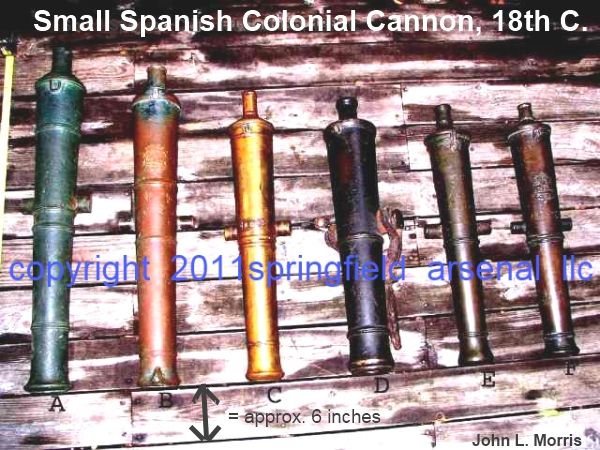The item shown is what we cannon collectors call a "decorator." It was probably cast in the late 19th C. or sometime during 20th C. It was made for the same folks who like to decorate with repro suits of armor and repro halberds, broadswords, etc. on the walls. I've seen similar cannons with different decorations that I knew were probably cast in 1950's or 60's. Some were accompanied by stories about being dug up near St. Augustine, FL.
A real Spanish cannon of about that size looks a lot different and weighs about 70+ lbs.; I've seen many and have photos and data on them. There are large Spanish cannons cast in Lima with dates in Roman numerals near the muzzle but those numerals run in a belt around the muzzle. The area where the phony Roman numerals appear on this item is where the "given name" of a Spanish cannon normally appears, either cast-in (early) or engraved (18th-19th C.) The muzzle-to-trunnion diameter ratio is higher than seen in most Spanish cannons. Small Spanish cannons normally have no dolphins. The smallest Spanish cannon I've seen dolphins on is a 3-pounder field gun at USNA that was cast in the Philippines (Manila) ca. 1780. It weighs around 300 lbs and is around 4 feet long. The vent on this item is simply drilled with no vent field at all and small real ones I've seen normally have some sort of vent field (raised moulding.) The general design of this tube is quite different from the few basic small-Spanish cannon tube designs I know of. This item lacks the weight marking required on all Spanish cannons; usually seen on the trunnion but can show up on top of breech also. Cascabel of small Spanish cannon is usually a hollow tube, however don't confuse real Spanish cannons with Malaysian Lantakas, they are a whole different animal.
Here are real Spanish cannons from about 30" to about 50" long; each plank is about 6." The lightest of these cannon tubes is about 75 lbs.
"C" is the one Allen (Kabar2) got for me way back when. It still has a West Point Museum ID tag on it and the curator at that place about had a heart attack when he saw it in a display I had at a gun show. Fortunately I had already traced it down to the massive scrap-metal donation West Point made during WWII, something like 300 tons of old cannons, and the former curator knew all about that.
